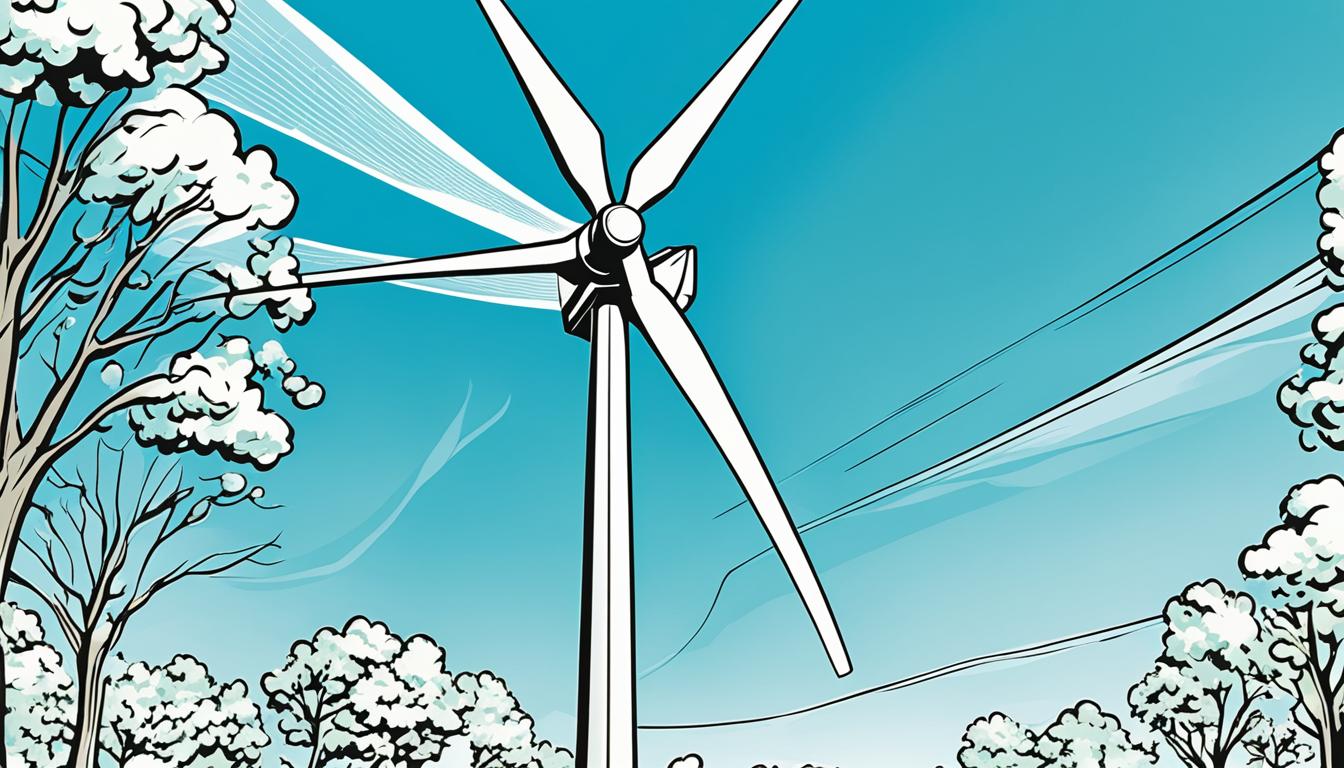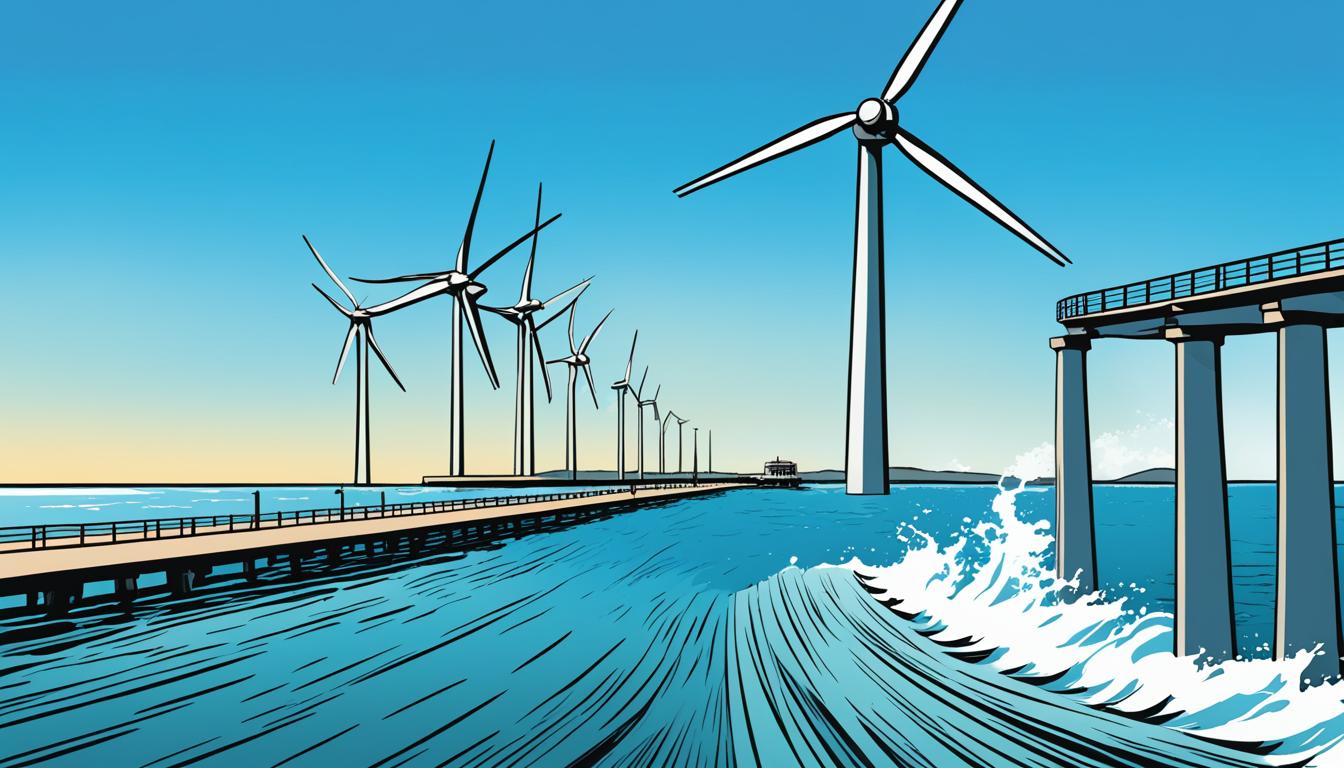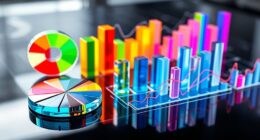Did you know that windmills first appeared in Persia in the 9th century? They spread across Eurasia with the growth of Islam1.
In the early 17th century, the Netherlands, the United Kingdom, and northern Europe widely used windmills. They ground grain and pumped water1.
On the flip side, wind turbines change wind into electricity by spinning a turbine. They have existed since approximately 18882.
Wind turbines create half of Denmark’s yearly electricity. This shows their big role in the country’s energy use1.
Wind turbines come with various blade sizes. Siemens Gamesa agreed to make 108 meter-long blades for a Scottish wind farm. One blade can power, on average, 800 U.S. homes1.
By mid-2022, the biggest wind turbines were 280 meters tall. This shows how much wind turbine tech has improved1.
Key Takeaways:
- Windmills originated in Persia in the 9th century and spread across Eurasia with the dissemination of Islam. 1
- Wind turbines convert wind energy into electricity and have been around since roughly 1888. 2
- Wind turbines generate half of Denmark’s annual electricity consumption, making a significant contribution to the country’s energy mix. 1
- Wind turbine blades can reach lengths of 108 meters (354 ft.), enough to power around 800 U.S. homes per blade. 1
- The tallest wind turbines reached heights of 280 meters (918.6 ft) by mid-2022, showcasing advancements in wind turbine technology. 1
Windmill: A Historical Technology for Mechanical Energy
Windmills date back to ancient times and have a rich history. They turned wind into mechanical energy for tasks like grinding grain and pumping water. These devices were key in advancing human civilization.
The story of windmills begins in the 1st century AD with Heron of Alexandria. They became more popular in 9th century Persia for grinding grains and water management3. These early models were simple but got the job done by using wind to move their blades.
By the 13th century, windmills reached China and Europe. In Europe, the horizontal axis kind was used mainly for grain3. These had large sails to catch wind, turning it into the motion that ground flour.
Windmills also powered saws for cutting timber and helped make paper. In places like the Netherlands, they pumped water to farm land below sea level. Windmills could do many jobs, all powered by the wind.
The first wind turbine making electricity was built in 1887 in Cleveland, Ohio3. It made 12 kilowatts of power. Over time, wind turbines grew bigger and better, making about 3 kilowatts in the 1920s3.
Windmills have evolved into modern wind turbines. In the US, six million windmills generate electricity4. Small ones make 1 to 25 kW, while big turbines can do 50 kW to 600 kW. The biggest ones in wind plants can produce 9.5 MW4.
Wind energy is a major renewable energy source in the US4. It’s growing by about 30% each year. This shows how wind power is expanding quickly. Plus, it’s getting cheaper, so it’s a good choice for clean energy, says the National Renewable Energy Laboratory4.
Wind Turbine: Harnessing Wind for Electricity Generation
Wind turbines turn wind energy into electricity. They work by spinning blades that drive a generator. The first wind turbine for making electricity was built in 1887. Since then, technology has improved, allowing longer blades to capture more wind over a bigger area. Today, wind turbines are a clean, reliable electricity source. Denmark is at the forefront of wind technology.
Wind turbines are key for electricity generation. In the U.S., they generate over 10% of the nation’s electricity needs5. A single 2.8-megawatt (MW) wind turbine can power 100,000 homes5. Smaller, distributed wind turbines provide 1 to 10 kilowatts and can be set up near homes5.
Utility-scale wind turbines vary in size. They can produce from 100 kilowatts to several megawatts5. These turbines use wind currents across the country and its coastlines. Wind farms, located on land and offshore, utilize the U.S.’s abundant wind5. Offshore wind projects are expanding, with turbines operating off the Atlantic coast in states like Rhode Island and Virginia6.
Wind turbines’ sizes and capacities differ by type and location. Small wind turbines for homes can generate up to 10 kilowatts (kW)7. The largest ones can generate 15,000 kilowatts (15 megawatts)7. These large turbines, often having a horizontal-axis design, can be as tall as 20-story buildings. Their blades stretch over 100 feet7.
The wind energy industry has grown significantly. The U.S. now has nearly 145,000 megawatts of wind energy capacity. The U.S. Wind Turbine Database records 73,352 turbines in the U.S., including Guam and Puerto Rico6. In Maryland, wind power makes up 1.3% of all electricity. The state plans to grow this through new projects6. Maryland’s offshore wind will create 12,000 jobs and generate 2,022.5 megawatts6. However, concerns exist about the impact of turbines off Ocean City on tourism6.
Key Differences Between Windmills and Wind Turbines
Windmills and wind turbines harness the wind’s power. Still, they differ in structure, use, and how they work.
Structure
Windmills have wide blades close to the ground to catch air currents. This design uses the wind’s pressure difference. Wind turbines, however, are taller and reach higher altitudes for stronger currents. Their high position catches faster, more stable winds, boosting energy production.
Purpose
Historically, windmills ground grain and pumped water for farming and industry. They played a key role in grinding grains and driving water pumps. Wind turbines, though, aim to turn wind’s kinetic energy into electricity. They generate clean, renewable power on a grand scale.
Working Principle
Windmills work by using the wind’s pressure difference to move their blades. When wind hits the blades, it spins them, turning mechanical energy into work for milling or pumping. Wind turbines use lift and drag forces to rotate their blades. Like airplane wings, their blades lift with the wind, spinning a generator to make electricity.
These differences show windmills and wind turbines’ unique uses and benefits. Windmills have historically provided mechanical energy for milling and pumping water. Wind turbines, however, focus on converting wind energy into electrical power, significantly impacting renewable energy today.
| Windmills | Wind Turbines |
|---|---|
| Used for milling grain and pumping water | Used for generating electricity |
| Originated in Northwestern Europe in the 12th century8 | First invented in Cleveland in 18878 |
| Average height between 40 and 60 meters8 | Constructed between 60 and 100 meters tall8 |
| Primarily powered by the wind’s pressure difference8 | Operate based on lift and drag forces8 |
| Controlled by a main turbine controller for safe operation9 |
Applications of Windmills and Wind Turbines
Windmills and wind turbines serve different purposes, like grinding grain or making electricity. These inventions have changed many industries and encouraged green living.
Historical Applications of Windmills
Over a thousand years ago, windmills started in Persia and China. They ground grain and pumped water10. They reached Europe and boosted agriculture and economies10.
Different windmill designs, like post mills and tower mills, were created10. They used sails to catch wind, which turned a shaft for grinding or other tasks10.
Modern Applications of Wind Turbines
Now, wind turbines mainly generate electricity10. Most are horizontal-axis types, with blades rotating around a shaft. There are vertical-axis turbines too; they are easier to fix because they’re closer to the ground10.
Wind turbines convert wind into electricity for homes, businesses, and towns10. Onshore farms are usually in windy rural areas. Offshore farms, in the sea, get stronger winds10.
Diverse Range of Applications
Wind turbines have many uses beyond making electricity. Big land-based turbines form wind plants, powering the grid11. Huge offshore turbines harness ocean winds for a lot of energy11.
Smaller wind turbines work for homes, farms, and small businesses, providing local green energy11. Hybrid wind systems mix small turbines with other energy sources. They help remote or grid-connected places become more resilient and energy-independent11.
Notable Wind Power Projects
The Jaisalmer Wind Park in India was the world’s biggest onshore farm in April 2012, making 1,064 megawatts12. The Walney Wind Farm in the Irish Sea is the largest offshore, with 367 megawatts12. These projects show the big potential of wind energy for sustainable development and fighting climate change.
For centuries, windmills and turbines have been valuable. They’ve gone from grinding grain and moving water to making electricity and empowering communities. As they evolve, they’re crucial for our energy needs and reducing fossil fuel use..

| Application | Windmills | Wind Turbines |
|---|---|---|
| Grinding Grain | ✔ | |
| Pumping Water | ✔ | |
| Mechanical Energy | ✔ | |
| Electricity Generation | ✔ |
Environmental Impact of Windmills and Wind Turbines
Windmills and wind turbines are key to lowering environmental harm and supporting green energy. While windmills have been around for a long time, wind turbines are newer. They use wind to make electricity. Let’s look into how both benefit the environment and things to consider.
Windmills: A Historical Technology for Mechanical Energy
Windmills, used for centuries, change wind power into mechanical energy. They helped in grinding grains or pumping water. Unlike wind turbines, windmills don’t make electricity or greenhouse gases. They are sustainable and good for the planet.
In places like farms or islands where wind is strong, windmills are especially useful. They help reduce dependency on traditional energy sources. This supports sustainable growth in those areas. States and local groups can boost their economy with windmill projects. They can generate about $2 billion a year in tax and lease payments13.
Wind Turbines: Harnessing Wind for Electricity Generation
Wind turbines turn wind into electricity. They are important in renewable energy, offering an alternative to fossil fuels. In the U.S., wind energy helps cut down 336 million metric tons of CO2 every year. This is like taking 73 million cars off the road13.
New wind projects bring in $20 billion to the U.S. economy in 2022. Wind turbines are in all 50 states, providing over 10% of the nation’s energy13. This creates jobs, with over 125,000 people working in the wind industry. The job of wind turbine service technician is growing fast13.
Wind energy is also one of the cheapest sources today. When comparing costs of new power plants, wind and solar are more economical than gas or coal13. This, along with its environmental perks, makes wind energy a sustainable choice for the future.
Environmental Considerations and Future Research
While wind turbines are beneficial, they may affect wildlife. Research is being done to reduce the impact on birds and bats. This includes using sound and light to warn wildlife13.
Wind turbines also have much lower CO2 emissions compared to traditional energy. They emit between 0.02 and 0.04 pounds of CO2 per kilowatt-hour. This is much less than coal or natural gas14.
Efforts are underway to make turbines more efficient and environmentally friendly. The goal is to improve blade design and connect wind-rich areas to cities more easily. This will lower costs and boost land-based wind energy13.

Windmills and wind turbines have changed how we make energy, offering a clean, low-carbon alternative to old power sources. They help the environment and the economy. Continuing to invest in this technology is important. We must focus on research to lessen any bad impacts on wildlife and make wind energy even more sustainable1314.
Advancements in Wind Turbine Technology
Wind turbine technology has made great strides. It now uses longer blades and taller towers to catch more wind. These changes have made it possible to produce clean, sustainable electricity on a bigger scale.
The longer blades are crucial for getting more wind energy. They cover a bigger area and transform more wind into power. This not only makes wind farms more efficient but also cuts down on the number needed, saving space and money15.
Taller towers help turbines reach stronger winds high up, boosting their output. The tallest ones now stand at 280 meters, even taller than the Statue of Liberty. Getting higher helps capture more wind, making the turbines work better15.
“Innovations in wind energy technology, such as longer blades, taller towers… are paramount in reducing the cost of energy and expanding access to clean wind energy.”
– Wind Energy Technologies Office, U.S. Department of Energy
These improvements mean wind turbines work much more efficiently. With longer blades and taller towers, they turn more wind into electricity. This helps wind power compete in price with other energy types, encouraging a move to cleaner energy15.
Thanks to these improvements, wind energy fits better into our power grid. More efficient turbines cut down on carbon emissions and lessen our need for fossil fuels. Wind power is becoming a cheaper, more stable option for us all, helping both customers and the environment16.

Wind turbine tech has seen major upgrades, with longer blades, taller structures, and better efficiency. These steps forward have boosted wind power as a clean alternative to traditional energy, leading us to a greener future. By using the wind’s power, we are on our way to a more sustainable energy system. This reduces our impact on the planet and safeguards it for future generations.
Wildlife Impacts of Windmills and Wind Turbines
Windmills and wind turbines help us make clean energy. However, they can harm wildlife, especially birds and bats. Studies show that newer wind turbines pose more risks to wildlife than old-fashioned windmills do.
About 0.26 animals die each year per wind turbine17. Some areas with no turbines have more types of birds than areas with turbines17. Animals like Blackbuck and Golden Jackal avoid places with many wind turbines17.
India ranks 4th in wind energy with 37,744 MW installed since 199617. These wind farms are mostly in Reserved Forests. Only Papanasi is on farmland17.
Wind turbines have powers from 0.8 to 1.25 MW17. A study searched for bird and bat deaths around turbines17. It found fewer birds and bats near turbines compared to areas without them17.
Smaller wind turbines make less noise, which is better for animals18. Still, birds hitting turbine blades is a big worry. Small turbines near homes can threaten birds18. Automaxx improved design to stop this from happening18.
Putting up small wind turbines can disrupt local plants and animals. Automaxx checks the environmental impact before setting up turbines18. They work on fixing damages and reduce electromagnetic effects on nature18.
When choosing sites for turbines, companies think about the wildlife around18. Experts are making turbines safer for animals with new technology18. Talking to communities and wildlife groups is key to find solutions18.
Wind energy is cheap and doesn’t pollute, but it’s not perfect for wildlife19. Offshore wind turbines can also harm sea life19. Developers use radar and cameras to lessen the damage19. They try not to build during animal breeding times19.
Wind farm teams work to reduce harm to wildlife. They keep an eye on the area for a year after starting19. Teaming up with other countries helps find better ways to protect nature19.
Historical Significance of Windmills and Wind Turbines
Windmills and wind turbines have been important for a long time. They show how clever early civilizations were and how renewable energy has grown.
From as early as 5,000 BC, wind helped boats move on the Nile20. By 200 BC, China used wind to pump water and the Middle East was using windmills to make flour20.
In the 11th century, the Middle East started using wind pumps and mills in farming20. These early windmills were crucial. They helped grind grain and pump water.
In the 19th century, the Halladay Windmill changed farming20. Invented by Daniel Halladay and John Burnham in the 1850s, it let farmers do more with wind power.
The change from old windmills to electric wind turbines started in 1887 in Scotland20. James Blyth built the first wind turbine. This was a big step toward clean electricity from wind.
Today, wind energy is key in fighting climate change. Many countries, like the USA and China, are installing more wind power. This helps lower carbon emissions.
| Country/Region | Installed Wind and Solar Capacity (2024) | Projected Installed Coal Capacity (2024) |
|---|---|---|
| China | 800+ GW |
Wind power has grown fast worldwide20621. In the USA, it went from under 1% of electricity in 1990 to over 10% in 202221. China is now the top wind power producer21. By 2024, China’s wind and solar capacity will beat coal20. This shows a big move to clean energy.
There are 145,000 megawatts of wind power in the U.S., spread over 73,352 turbines6. Offshore winds are strong, so offshore farms are becoming popular. Maryland is working on big offshore wind projects. These will create jobs and more power6.
Windmills and wind turbines have a rich history. They’ve been used from early times for work to today’s clean energy. Wind power has been key throughout history. It shows our shift towards renewable energy and a better future.

Windmills and Wind Turbines in Modern Energy Strategies
Windmills and wind turbines are important in today’s energy plans. They help move us towards using renewable energy. While windmills have been around doing mechanical tasks, wind turbines are now crucial for making electricity.
Windmills have been used for centuries to grind grain and pump water, especially in rural places22. They stand as symbols of sustainable farming and self-reliance with their spinning blades.
In contrast, wind turbines take wind power to a new level by generating electricity on a large scale23. As the world seeks cleaner energy to fight climate change, wind turbines have become essential.
Wind turbines work best at wind speeds between 7mph and 56mph23. They reach their highest efficiency at around 18mph. Wind turbines are designed to generate a lot of power, which helps produce electricity worldwide.
The positive impact of wind turbines on the environment is huge. They lower greenhouse gas emissions by using wind instead of fossil fuels. This change is key for a greener, more sustainable future23.

Wind turbines are set up on land and in the sea23. Onshore farms are usually in rural areas, while offshore ones are out in the ocean. Each location offers different benefits and things to consider.
To blend into the environment, wind turbines are often painted white or light grey23. Some people suggest painting them green to help them blend even better.
In 2021, the U.S. made a big mark in wind energy. Wind turbines generated more than 9% of its electricity24. With new installations, the total wind capacity hit 135,886 MW24.
| Country | Percentage of Electricity from Wind |
|---|---|
| Denmark | More than 20% |
| Portugal | More than 20% |
| Ireland | More than 20% |
| Iowa (US) | Over 50% |
| South Dakota (US) | Over 50% |
| Kansas (US) | Over 30% |
| Oklahoma (US) | Over 30% |
| North Dakota (US) | Over 30% |
The United States is the second-largest producer of wind energy, after China24. Wind power is safer for birds than buildings or cats. Plus, the noise from wind plants doesn’t harm humans24./articles/wind_energy_and_wildlife.html>.
Windmills have a long history, being around for over 1000 years. At their peak, there were 200,000 in Europe22. Today, about 1,000 are left, mostly for learning and as museums22. Wind turbines, though newer, have grown fast. Now, over 341,000 are working globally22.
Building modern wind turbines uses materials like carbon fiber for blades and steel for towers22. These materials ensure turbines last a long time, even in tough conditions.
Both windmills and wind turbines have a place in today’s renewable energy efforts. Wind turbines supply a lot of our electricity, while windmills keep their historical importance. Together, they show how old and new technologies can work together for a sustainable future.
The Future of Wind Energy
Wind energy is crucial for the future of clean electricity. As we shift to renewable energy, wind turbines will be key for clean power.
Wind energy makes up 6.3% of the U.S. electricity supply25. The U.S. has over 58,185 wind turbines in 43 states, Guam, and Puerto Rico, producing over 90 gigawatts. The offshore wind sector could add more than 25,000 megawatts of power in 13 states.
Wind turbine technology is always improving. Today, turbines range from 100 kilowatts to several megawatts. Large offshore turbines are efficient and powerful. Small wind turbines, under 100 kilowatts, provide energy for homes, farms, and small businesses off-grid.
Efforts to reduce carbon emissions have boosted wind energy use. In the U.S., wind power has tripled in the last ten years26.
Wind energy is both eco-friendly and economical. It’s a sustainable energy choice as clean sources become more important.
Over 125,000 people worked in wind power in 202227. By 2050, this could reach 600,000 jobs.
Denmark is a leader in wind energy, generating 47% from wind in 201926. Investment in wind farms and projects is growing globally.
The Haliade-X in the Netherlands is the largest offshore wind turbine at 260 meters tall. It can produce 262 megawatt hours of energy in one day. This shows the potential of wind power.
Wind energy is leading the way to a more sustainable future. It’s vital for generating electricity, creating jobs, and protecting the environment. Wind turbines will help meet global energy demands and reduce fossil fuel use.
| Statistical Data | Source |
|---|---|
| Wind energy contributes to 6.3% of the nation’s electricity supply | Link 1 |
| In the U.S., there are more than 58,185 land-based wind turbines operational across 43 states, Guam, and Puerto Rico, with a capacity of over 90 gigawatts | Link 1 |
| The U.S. offshore wind industry has over 25,000 megawatts of potential capacity across 13 states | Link 1 |
| Wind power has tripled over the past decade | Link 3 |
| Over 125,000 people employed in the wind power industry as of 2022 | Link 3 |
| Denmark had the highest wind power generation in the world in 2019, reaching 47% | Link 3 |
| The Haliade-X in Rotterdam, the Netherlands, is the world’s largest offshore wind turbine, standing at 260 meters (853 feet) with a capacity of 12 megawatts and having set a world record by producing 262 megawatt hours of clean energy in a single day | Link 3 |
Conclusion
It’s important to know how windmills and wind turbines differ. This helps us understand how wind power technology has grown. Windmills were first made for mechanical power. But, wind turbines now use wind to make electricity. The journey of wind turbines began in Ohio in 18889. Since then, they have become much bigger and more advanced.
Today’s wind turbines can be really tall, from 30m to 100m. This height helps them catch better winds to produce electricity more effectively. They have special blades and control systems. These features make sure they work safely and efficiently9. Wind turbines also have smart systems. These systems help manage their operation and connect with a central control9.
Windmills, however, have been used for a long time for tasks like grinding grains and pumping water. They create mechanical power for physical jobs28. Unlike windmills, wind turbines use the wind differently. They turn wind’s movement into electricity for homes and businesses29.
Wind turbines are now key for making clean, affordable electricity. They are a big help in our shift to more green energy29. With their help, we’re headed towards a world that’s better for the environment.









